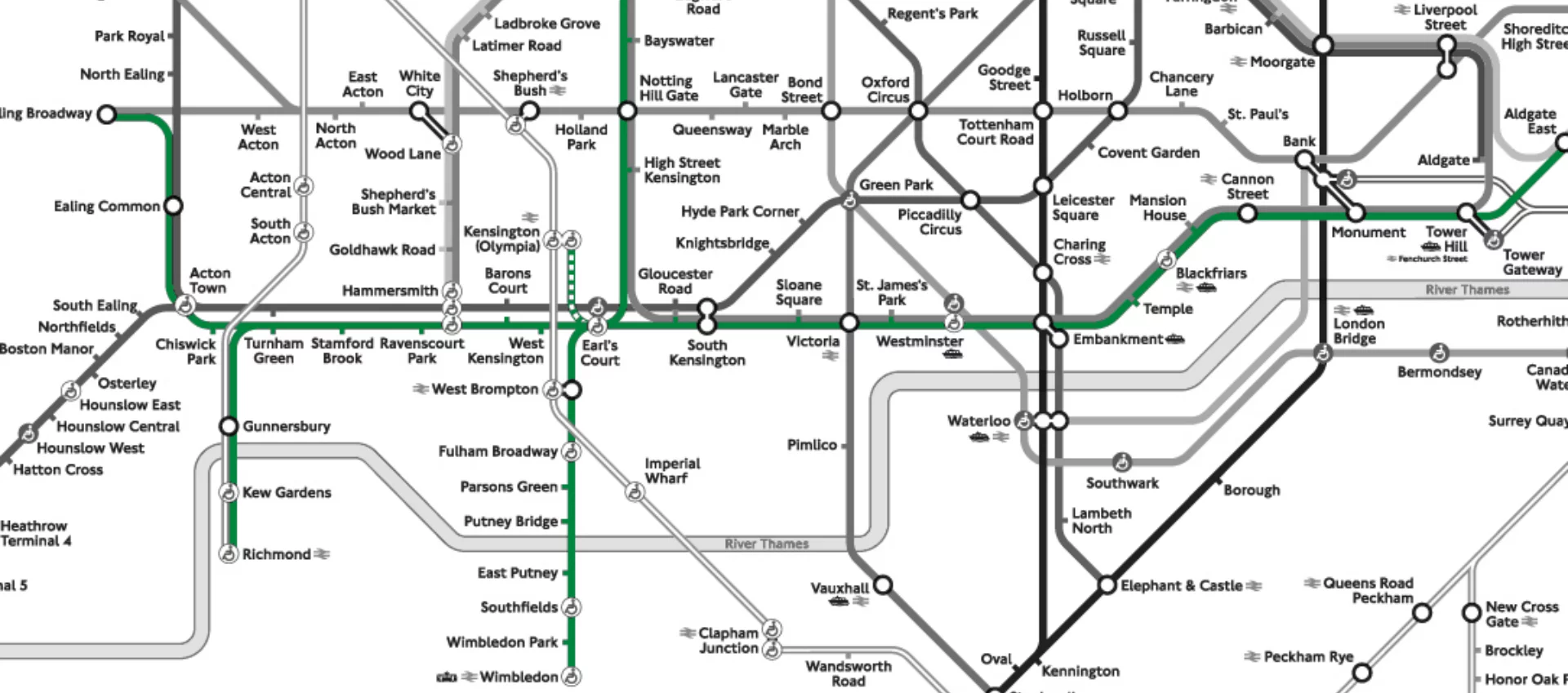You’re probably here because of our list, An Interesting Fact About Every London Tube Station.
Now, like the Underground itself, the list is pretty huge. And also like the Underground, we thought we’d make it easier to navigate – so we also created a little splinter list dedicated to stations on The District Line. A list which, lo and behold, you’ll find on this very page…
Richmond
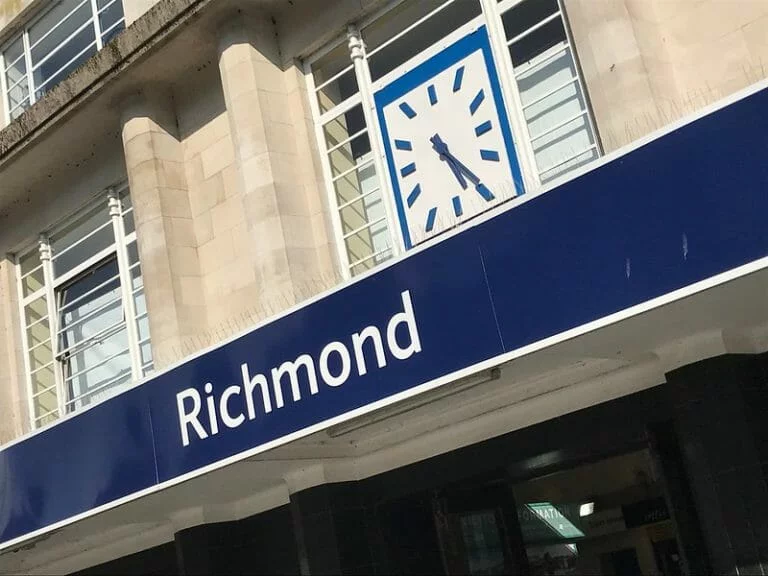
Matt Brown / Flickr
Built from Portland Stone – a Jurassic era limestone from Dorset used in the construction of Buckingham Palace, St. Paul’s Cathederal, and the UN Building in New York.
Kew Gardens

Tom Parnell / Flickr
The Tube’s track is crossed by Kew Gardens Station Footbridge, a Grade II listed feature in its own right – it was designed specifically to prevent smoke from steam trains getting into people’s clothing.
Gunnersbury
On 8 December 1954 the station was damaged by a tornado which ripped off the roof and injured six people.
Ealing Broadway
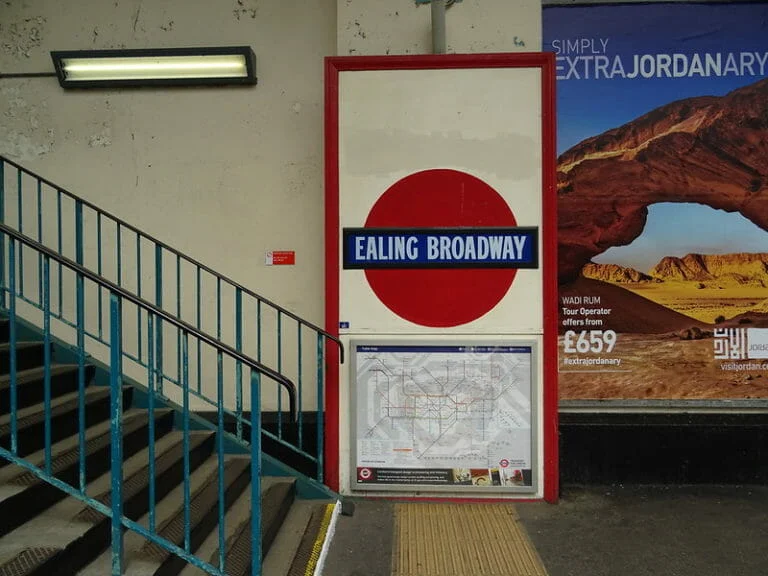
Andy Aldridge / Flickr
Platforms 8 & 9 still contain some of the pre-roundel logo designs.
Ealing Common
Has a heptagonal ticket hall, one of only two on the network.
Acton Town
Alphabetically, the first tube station on the network.
Chiswick Park
Once known as Acton Green – the name was changed due to there being 7 other Acton stations already.
Turnham Green
Wheeler’s Florist, based directly outside the station, has provided flowers for Bond & Batman movies. Which, apparently, had flowers in them.
Stamford Brook
Was the first tube station to have an automatic ticket barrier installed on 5 January 1964.
Ravenscourt Park
Is the least Instagrammed station in London, with zero posts for 2016.
Hammersmith
Technically, it’s two stations – one District/Piccadilly, one Hammersmith & City/Circle. And to get from one to the other without walking would require a minimum of 10 stops and 3 changes.
Barons Court
Mahatma Gandhi lived at 20 Barons Court Road, a few yards from the station, while studying law.
West Kensington
Being next to the Queen’s Club, it’s 5x closer to a grass court tennis court than Wimbledon station.
Wimbledon
Laddie the Airedale Terrier was based at the station for six years, before retiring in 1956. During his time there, he collected £5,000 pounds in the change box on his back.
Wimbledon Park
Despite being the closest station to the All England Club, it’s still closer to Wimbledon golf club than the tennis club.
Southfields

Alvin Leong / Flickr
The station platform undergoes a makeover each year to coincide with the Wimbledon tennis tournament.
East Putney
On 1 April 1994, it was sold to London Underground for the sum of £1.
Putney Bridge
Technically not in Putney – it’s on the Fulham side of the Thames.
Parsons Green
Is an anagram of “Passenger Ron”.
Fulham Broadway
It’s the station in 1998’s Sliding Doors, where reality changes because of a missed train.
West Brompton
Was closed due to bombing in 1940, and not reopened until 1999.
Kensington (Olympia)

Kake / Flickr
The station’s old name, ‘Addison Road Station’ still appears sculpted into a wall on the eastern pedestrian exit.
Earl’s Court
The site of the last remaining blue police telephone box – radios took over in the 1970s.
High Street Kensington
Once had a waiting room for passengers who didn’t fancy the platform. This was changed into a break room for drivers.
Notting Hill Gate
The reason it’s called Notting Hill Gate is because it was literally a gate: it used to be a toll road.
Bayswater
Was originally called Queen’s Road (Bayswater), but the name was changed to avoid confusion with Queensway, which was also called Queen’s Road. And the kicker? There is no Queen’s Road in Kensington.
Paddington
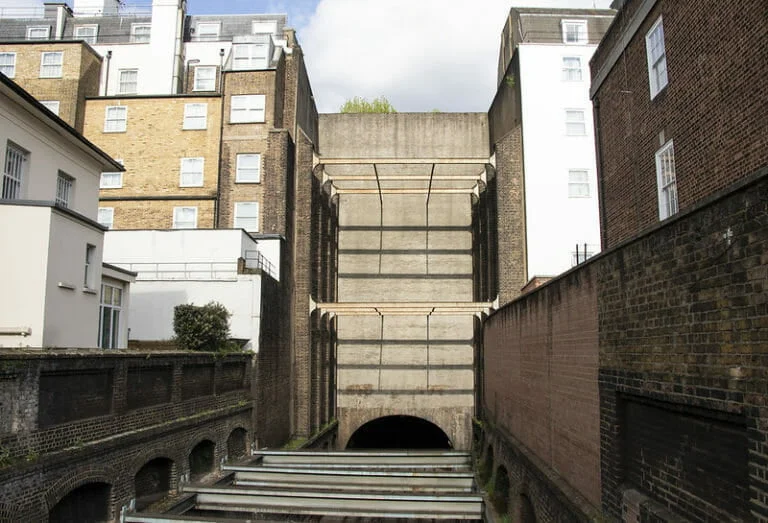
Jeremy Segrott / Flickr
The track running towards Bayswater passes under 23-24 Leinster Road – a facade constructed to match neighbouring terrace houses. disguising where the original house was demolished to allow a gap in the tube system for steam trains to er…let off steam.
Edgware Road
Has a “living wall” wall of plants outside the station, the only one in the underground network.
Gloucester Road

Ian Wright / Flickr
Has a disused platform that’s used as an art exhibition. (Technically making it a used platform.)
South Kensington
Between South Kensington and Knightsbridge, the tube steers away from following the road above it in order to avoid a large plague pit.
Sloane Square
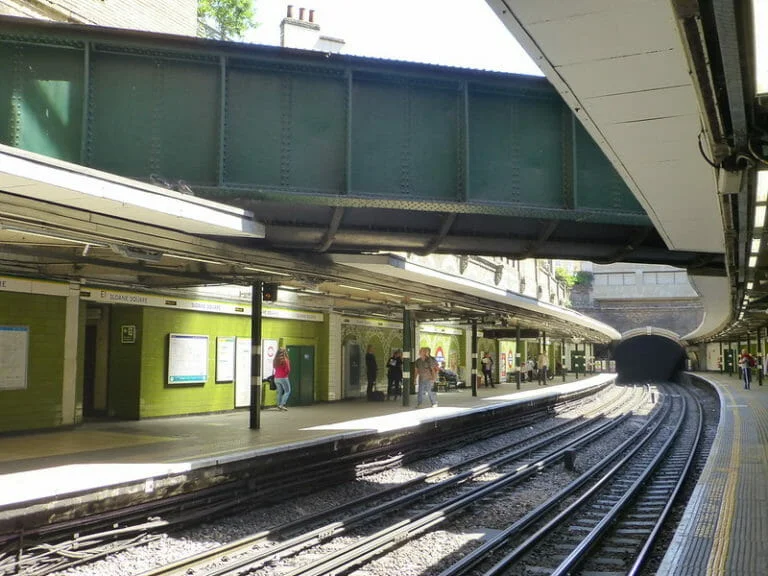
City Transport Info / Flickr
The River Westbourne runs through the station – it was redirected through its own little bridge suspended over the main platform.
Victoria
Plays a key role in Oscar Wilde’s ‘The Importance of Being Earnest’ – the main character was discovered as a baby in a handbag in the station.
St James’s Park
Is a Grade 1 listed building, making station improvements considerably difficult.
Westminster
Excavations for creating the deep level Jubilee line platforms caused Big Ben to move 35mm. Any more, and the tower would have cracked and possibly collapsed.
Embankment
Has a huge, empty substation attached to it, abandoned since 1957. Called ‘Pages Walk’ it’s behind a blast door in the station, and is so large it’s been proposed as a possible nightclub location.
Temple
On the columns at Temple station, there are small temple-shaped emblems at the bases.
Blackfriars
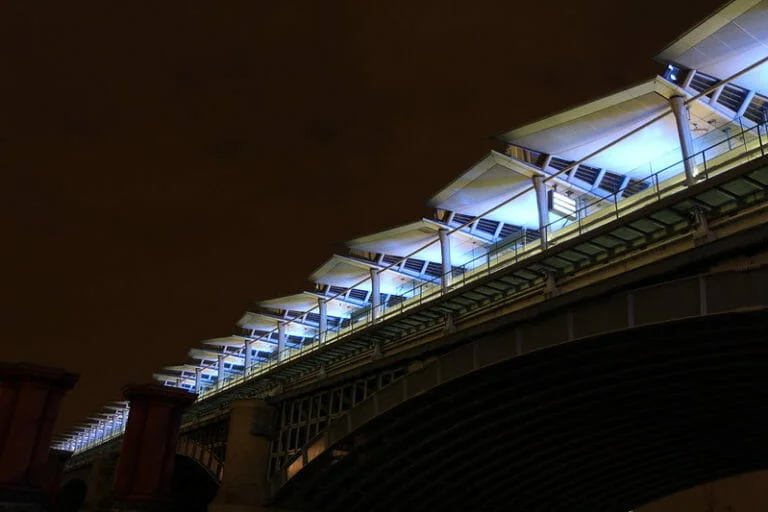
Jonathan Beeston / Flickr
In January 2014 the Blackfriars Railway Bridge became the world’s largest solar-powered bridge, having been covered with 4,400 photovoltaic panels providing up to half of the energy for the station.
Mansion House
Has all five vowels in its name.
Cannon Street
The name first appears as ‘Candelwrichstrete Street’ in 1190. The name was shortened over 60 times as a result of the local cockney dialect and settled on Cannon Street in the 17th century, and is therefore not related to the firearms.
Monument
It’s original name, Eastcheap, lasted precisely one month before it was changed to Monument.
Tower Hill
King Henry VIII beheaded noble traitors to the crown and two of his wives here. Not like, IN the station, but next door to it.
Aldgate East
The station was moved by just a few feet in 1938 in order to make the curve of the track slightly more gentle. In order to do this, the entire track had to be lowered by 2m in one night. The ground below the track was excavated during the day (with the rails held up by a wooden trestle <em>while trains still ran over them</em>), and 900 workmen simultaneously eased the rails down after the station closed. It reopened the next morning with no break in service.
Whitechapel
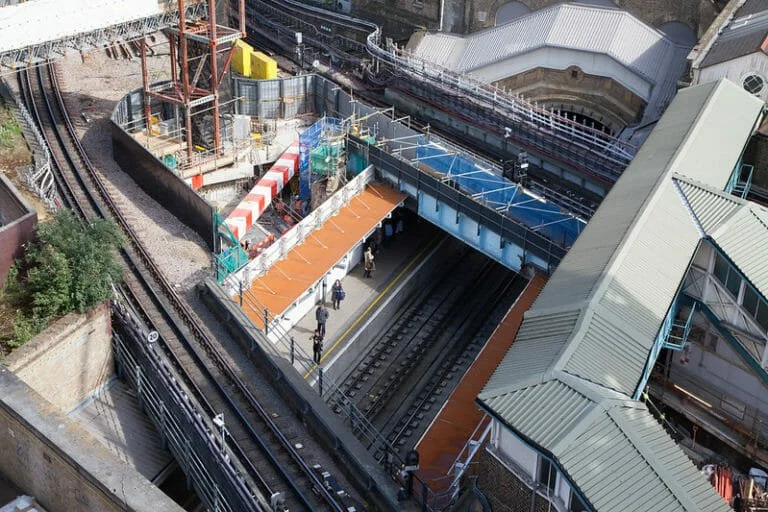
Tom Page / Flickr
Whitechapel is the only place on the network where the Overground runs below the Underground.
Stepney Green
A Tudor-era bowling ball was unearthed during the Crossrail excavations under the station.
Mile End
Is named so because it’s exactly one mile from the eastern boundary of The City of London.
Bow Road
The steepest gradient on the tube network.
Bromley-by-Bow
In EastEnders, the fictional Walford East tube station takes the place of Bromley-by-Bow.
West Ham
Has more platforms (8) than Charing Cross (6).
Plaistow
Prior to the station being put in, Plaistow was a whole day’s coach ride to Westminster due to the roads. Now, it takes less than half an hour.
Upton Park
The station’s name is slang for crazy (because they’re ‘two stops short of Barking’).
East Ham
Between 1851 when the station wan built, and 1911, East Ham’s population grew by 7585%.
Barking
Currently has a direct freight service running 7,500 miles direct to & from the city of Yiwu, on China’s east coast.
Upney
The Gunpowder Plot was hatched in a manor house next to the station.
Becontree
When Beacontree was first built in the interwar period, it was the largest housing estate in the world – and a railway station was built specifically for it.
Dagenham Heathway
Despite being smaller, and having fewer platforms, it gets twice the number of passengers per year as Dagenham East.
Dagenham East
Was the site of a rail crash in 1958 due to fog – the train that caused it is still active on the Severn Valley Railway.
Elm Park
Celebrations to mark the opening of the station in 1935 included a performance by the Dagenham Girl Pipers – they performed in Nazi Germany around the same time, and Hitler is said to have remarked “I wish I had a band like that.”
Hornchurch
In the 80 years since the station was built, Hornchurch’s population increased by 43 times.
Upminster Bridge
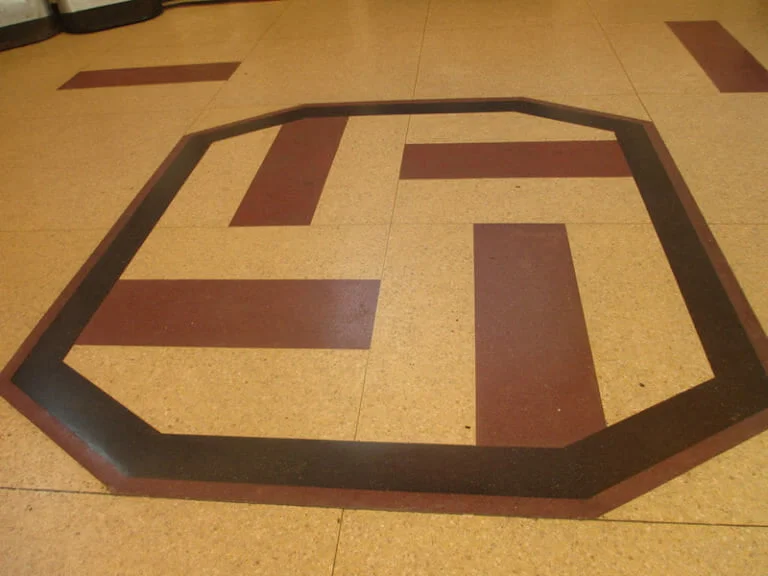
Matt Brown / Flickr
Displayed a swastika in its ticket hall when it was built in 1934. They took it down a few years later for some reason or another.
Upminster
The speed of sound was first accurately measured from a church about half a mile from the station.
Enjoyed these District Line facts? Check out the other lines right HERE.
